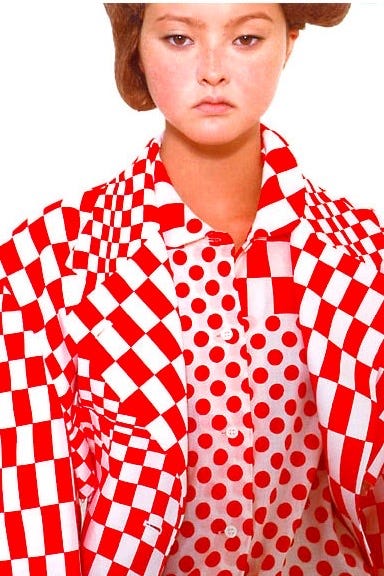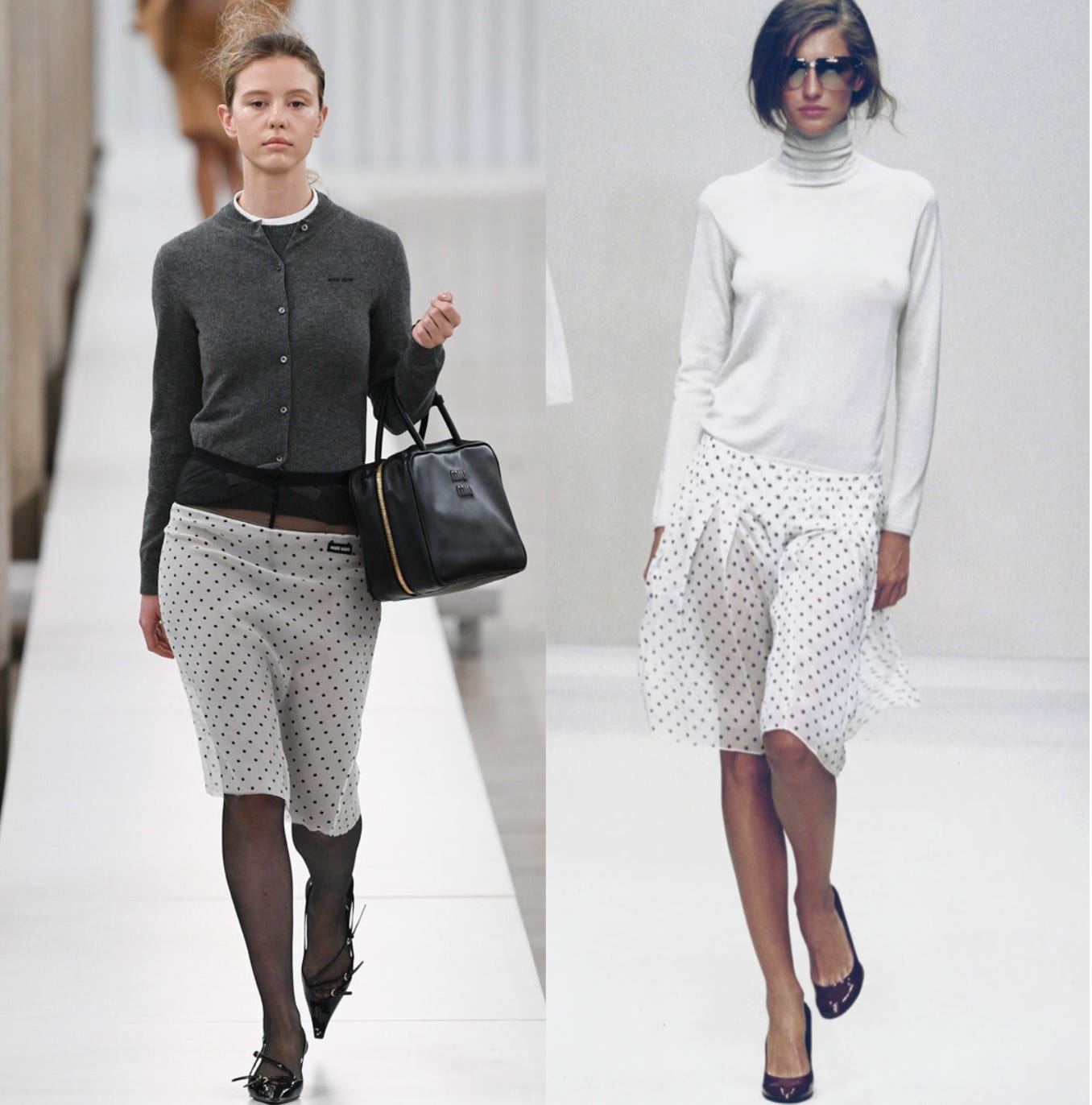No matter what I do, polka dots haunt me across the Internet. They find me in endless Instagram ads from every cool girl contemporary brand ever, in the GRWMs on my TikTok fyp, even on Vinted, where my algorithm has succumbed to the pox, spitting up spotted y2k adjacent Shein products. They are like the fashion version of a trending audio, algorithmically driven, suddenly everywhere and soon nowhere. Not very demure, not very mindful.
We could probably lay the blame at the hemline of the world’s hottest brand, Miu Miu, which sent a messy-haired Mia Goth down the runway in a librarian cardigan tucked into her tights and a sheer polka dot skirt (recalling Prada’s Spring Summer 2000 collection) back for Autumn Winter 2023. That, btw, was the same show that gave us the oval, tortoiseshell glasses that have been similarly impossible to ignore – a functionally useless signifier of trendiness: all plastic, no prescription.
The polkas have also been seen on runways at Marc Jacobs, Valentino, Balenciaga, Jacquemus, Acne… the list goes on. A notable mention here to my favourite starlet Addison Rae, who wore a pair of Moschino spotted hotpants on the cover of French Vogue, styled by Alastair McKimm.
With the exception of a Punkyfish tank top I took digicam selfies in back in my emo days, I have never liked polka dots. There’s something about their girlish connotations that I don’t relate to, a kind of feminine sweetness that has always disinterested me (at least without the wayward subversion implied by the backcombed hair of the Miu Miu models, making you wonder just what they’d been up to in between the library stacks.)
And yet… I am only human, and there are only so many times I can be algorithmically force fed a spotted Fruity Booty tank top without feeling a pang of desire rising from somewhere deep inside my guts. Maybe, I think, I do like polka dots?
This is the problem with how we consume trends now. We become malleable, we lose touch with our desire, with ourselves, with what we actually like and don’t. We are beaten into wilful submission by computer programming which determines our demographic and calls to us relentlessly, a siren song of data and code and the power of suggestion. I guess ad views are called impressions because we are impressionable.
I’ve been feeling brain-rotted lately, dumb and numb, and the relentless, inescapable dots have felt like a symbol of my out-of-control screen time. So, in an effort to sate my dotted desire and gain mastery over the algorithmic slop like Neo tearing through the Matrix’s primordial goop, I found myself researching other ways designers have used polka dots beyond the tired and tasteful cream and black combo.
Of course, there is polka dot obsessive Yayoi Kusama and her 2004 Louis Vuitton collaboration under Marc Jacobs, where the Japanese artist’s signature dots covered clothing and monogram canvas bags (and entire stores). Martin Margiela used blurry edged spots in his one of his final ready-to-wear collections, while John Galliano’s negative space take on a polka dot at Margiela was created by cutting out the spots, creating a net.
Rei Kawakubo has said that her earliest memories of fashion are of navy and white and polka dots, and the pattern has become a signature, appearing across the house’s many product lines from wallets to Converse, ready to wear to perfume. In my favourite Comme des Garçons’ collection, Spring Summer 2001 aka Optic Shock, polka dots were clashed dizzyingly with checkerboard prints. They have also dotted the brand’s Shirt line collaborations with Supreme, including the 2013 collection fronted by Chloë Sevigny.
Miuccia Prada has a long history with the prints, mixing them with stripes (Miu Miu Autumn Winter 2013) or the cartoonish, pop-art rendering of Spring Summer 2018. They also featured for Spring Summer 2021, Raf Simons’ first collection as co-creative director. And it turns out the little spots have a pretty interesting history. Back when weaving was done by hand, spot patterns were a no-no as the imperfect prints reminded people of leprosy and disease. It was the industrial revolution that ushered in beautifully precise dots that were far more appealing in societies that relied on neatness and order.
That Autumn Winter 2023 Miu Miu show was, according to the brand, “focused on the instinctive process of looking, ways of seeing, and how an act of observation can, in turn, transform the object of its focus”. If you’ve been anywhere near an arts or humanities degree, you’ll know all about Ways of Seeing, John Berger’s influential treatise on art, society, and perception.






In his chapter on publicity, Berger explores how that process of looking is integral to the ways in which advertising creates desire: not only in how we look at advertising images, but in how they inspire us to imagine ourselves, as seen by others. “The spectator-buyer is meant to envy herself as she will become if she buys the product,” Berger writes. “She is meant to imagine herself transformed by the product into an object of envy for others.”
Put another way: we don’t desire the polka dots, we desire the perception of ourselves by others as on trend. Or, in my case, trawling Vestiaire for Kusama printed LV Speedys, as both on trend… and also above it.








as someone also averse to polka dots, i appreciate this
I’ve experienced the exact same thing recently - hated polka dots my whole life now questioning whether they’re all that bad. THANK YOU for this